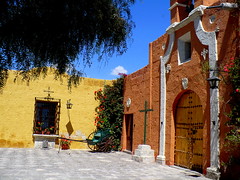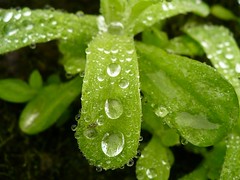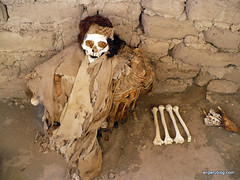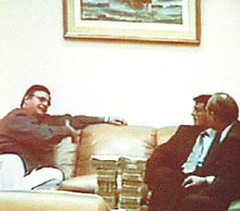Hatunrumiyoc and the Twelve Angle Stone
The origins of the magnificent ruins of a building that we call Hatunrumiyoc are lost in time. Built with huge polygonal stones, cut and fitted with exceptional precision, it is one of the most impressive structures of ancient Cusco. Its imposing walls hide a number of surprises, from the famous 12-Angle Stone, to shapes of local animals built into the structure itself.
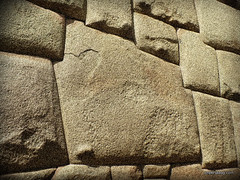
12-Angle Stone
Cusco’s early history isn’t clear. When the Spanish conquered the Inca Empire in 1532, it had only really existed for about 100 years. It was only when, in 1438, that Pachacutec became Sapa Inca, that the small Cusco city state began to be transformed into an empire by its new expansionist warlord leader.
This 100 or so year period from the conquest of the first strong regional rival to the Andes-spanning empire the Spanish encountered seems well documented. After the conquest, Spanish chroniclers were able the write the stories of the achievements of Pachacutec (1438-1471), Túpac Inca Yupanqui (1471-1493), Huayna Cápac (1493-1527), as well as Huáscar (1527–1532) and his civil war with half-brother Atahualpa (1532-1533) in a detailed way. The stories were common knowledge. But…
It was before this period of time where things get more confusing. Accounts differed about the era of the city state, about who did what and when. In fact, the Incas of imperial times are thought to have simply made up vast amounts of their early history and the stories surrounding their early leaders, for political reasons, to exaggerate their greatness to conquered tribes and for their own benefit, to “honour” their less war-like predecessors. Sapa Incas (kings) who were content to rule over their valley, or to extend their control over a village or two were exaggerated to be “great expanders of the empire”.
Hatunrumiyoc – Great Stone
This building, found on the street typically taken by tourists up to the modern district of San Blas and its bars, is from this time in Inca history. What it’s real name is no-one knows. The street is called Hatun Rumiyoc, a name given to it in much more recent times that in Quechua means big stone, supposedly referring to the famous 12-angle stone found in the wall half way up the street. This Inca building, which contains this stone, is in turn named after the street that is named after the stone. If the people of Cusco at the time of the conquest knew what the building’s name was, or who for sure built it, they unfortunately didn’t tell or were not asked by any Spanish chronicler.
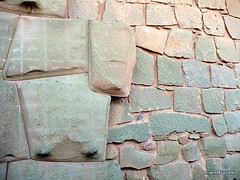
Colonial rebuilding attempts
So it is said, based on common opinion, that the building was the palace of Inca Roca, the sixth Sapa Inca who ruled sometime around 1350. But the Qoraqora, another building that is located on the plaza, is also said to be his palace. Perhaps they both were, or perhaps the Hatunrumiyoc was Sinchi Roca’s palace 100 to 150 years before. There’s no way to be sure who built it and when, and like the Incas, we have taken to inventing history for our own purposes. Maybe, contradicting the modern “inventions” of those academics who try to make sense these things today, one of the more fabulous local tales is true. One states that Inca Roca only rebuilt the structure, which had been in ruins for a unknown period of time, from the existing bricks he found scattered around. Who knows?
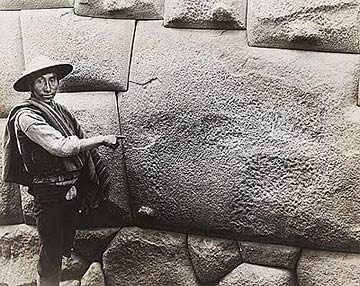
By Martin Chambi
What we do know about Hatunrumiyoc is that it is exquisitely constructed, reaching the same perfection of many other Inca structures. There were two main building styles used in Inca architecture, aligned rectangular bricks and complex jigsaw-like polygonal bricks like those used here and in Sacsayhuamán. Although the walls of polygonal bricks look more complex, perhaps they were easier to carve and set, mostly left in the natural shape in which they were found? (The Incas didn’t quarry stone, they collected from landslides) Regardless, it is this building style the allowed Inca architects get away with some really cool tricks.
Hidden Animals
The Incas considered many aspects of nature to be sacred, including animals. Their favourites, for reasons that they represented gods (e.g. snakes) or that they served a vital purpose for humans (e.g. llamas, guinea pigs), would sometimes be hidden in the brick designs of their buildings.
In the Hatunrumiyoc, which used to be about double its current height there are probably several. On one side of the building are these three below, but I think I found another couple on another side.
12 Angle Stone

12 Angles
Although not the Inca-carved stone with the most sides or angles (there is a 13 angle stone on the opposite side of the building, some say there is a 14 angle stone, and in other places in the region there are stones with up to 44 angles) but it is the stone that has its sides most clearly defined and placed together with such perfection. It is as famous for this perfection as its still quite extraordinary number of angles, becoming symbolic of the skill of Inca stonemasons and architects.
It has also become a local symbol and object of pride for Cusqueños and for Peru in general, perhaps what enticed two tourists from Chile (a neighbour who successfully invaded Peru and Bolivia for their mineral wealth) to deface it.
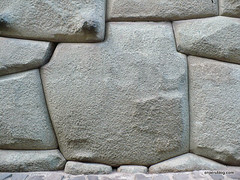
Less perfect 13 Angles
It now has someone to keep permanently watch, as well as dozens of young locals who point it out for a small tip.
* * *
Personally, this is my favourite building within the city of Cusco, as I am sure it is for many others. It is a terrible shame that only the bottom half of the wall survives, that sections are missing, and that the Spanish used such poor bricks to fill in the gaps.
What happened to the missing bricks? Did the Spanish tear them down, use them elsewhere, then regret it and rebuilt the structure for their own use? Were these ruins even in the time of the Incas? Did the walls collapse in colonial times?
I can’t find anyone who knows for sure. It’s sad how little is known, and how it has only been a few decades that anyone actually cared to know. You might say the Spanish chroniclers, who recorded something of Inca history, were better Peruvians than the post-Colonial Peruvians were.
If you have a theory or an opinion, feel free to leave a comment below.
Tags: 12-angle stone, 1500s, atahualpa, cusco, hatunrumiyoc, huascar, huayna capac, inca roca, incas, pachacutec, qoraqora, quechua, ruins, sacsayhuaman, san blas, sinchi roca, spaniards, tupac yupanki










